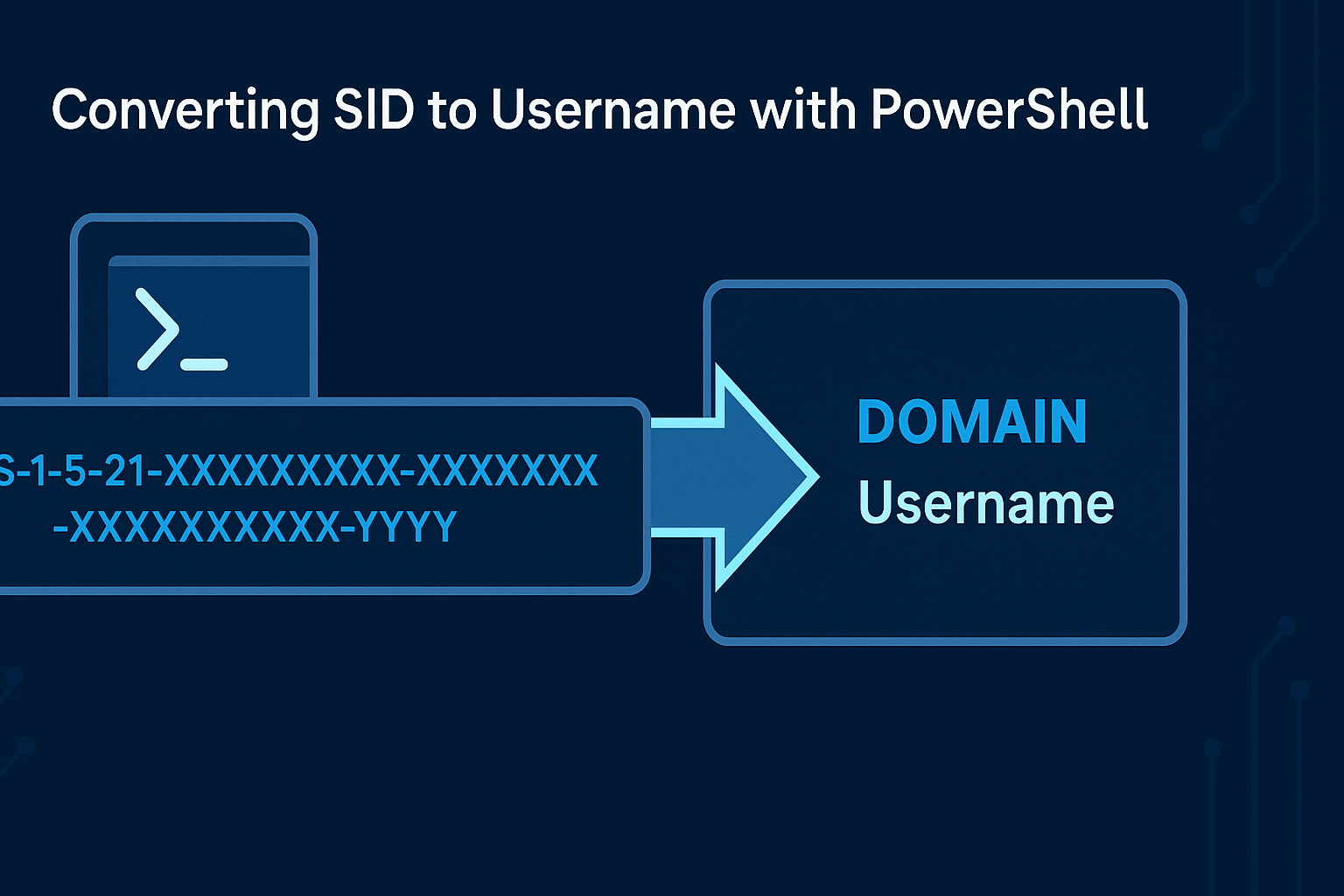In the complex world of Windows system administration, Security Identifiers (SIDs) serve as the backbone of the identity and access management system. While these unique alphanumeric strings precisely identify users, groups, and computers within Windows environments, they’re not particularly human-friendly. As IT professionals, we often encounter SIDs in logs, registry entries, or security settings and need to translate them to readable usernames.
This article demonstrates a simple yet powerful PowerShell technique to convert SIDs to usernames, essential knowledge for any Windows administrator or security professional.
Table of Contents
Understanding Security Identifiers (SIDs)
Before diving into the conversion process, let’s understand what a SID actually is. A Security Identifier is a unique value assigned to each security principal (user, group, or computer) when created in Windows or Active Directory. These SIDs follow a specific structure:
S-1-5-21-XXXXXXXXXX-XXXXXXXXXX-XXXXXXXXXX-YYYY
Where:
- “S” indicates this is a SID
- The numbers represent authority identifiers
- The “21” indicates a Windows domain or local machine
- The three XXXXXXXXXX segments form a unique domain identifier
- The YYYY part is the Relative ID (RID) that identifies the specific user or group
Windows uses SIDs rather than names to track permissions and access control, creating a need for tools that can translate between these formats.
The PowerShell Solution: Converting SID to Username
PowerShell provides an elegant method to convert a SID to a readable username using the .NET Framework classes. Here’s the simple code snippet that does the magic:
# Replace with the actual SID you want to query
$objSID = New-Object System.Security.Principal.SecurityIdentifier("S-1-5-21-XXXX-XXXX-XXXX-XXXX")
$objUser = $objSID.Translate([System.Security.Principal.NTAccount])
$objUser.Value
This three-line PowerShell command:
- Creates a new SecurityIdentifier object with the SID you want to convert
- Uses the Translate() method to convert it to an NTAccount object
- Retrieves the username value from that object
The result is displayed as “DOMAIN\Username” or “COMPUTER\Username” for local accounts.
Practical Applications
This SID-to-username conversion capability has several valuable applications in everyday IT administration tasks:
1. Troubleshooting Access Issues
When reviewing security logs with error messages that reference SIDs instead of usernames, this conversion allows you to quickly identify which users are experiencing problems.
2. Audit and Compliance
During security audits, you might need to verify who has access to specific resources. If permissions are listed by SID, converting to usernames makes verification much easier.
3. Scripted Automation
This conversion technique can be incorporated into larger automation scripts that manage permissions, generate reports, or perform bulk operations based on user identity.
4. Forensic Investigation
When investigating security incidents, log files often contain only SIDs. Converting these to usernames helps establish a clearer timeline of user activities.
Advanced Techniques and Error Handling
While the basic conversion is straightforward, production environments require robust error handling. Here’s an enhanced version of our script:
function ConvertSidToUsername {
param(
[Parameter(Mandatory=$true)]
[string]$SID
)
try {
$objSID = New-Object System.Security.Principal.SecurityIdentifier($SID)
$objUser = $objSID.Translate([System.Security.Principal.NTAccount])
return $objUser.Value
}
catch {
Write-Warning "Could not convert SID: $SID to a username. Error: $_"
return $null
}
}
# Example usage
$username = ConvertSidToUsername -SID "S-1-5-21-3623811015-3361044348-30300820-1013"
if ($username) {
Write-Output "The username for the SID is: $username"
}
This function catches exceptions that might occur if the SID is invalid or doesn’t correspond to an existing account, providing a more robust solution for production environments.
Going the Other Way: Username to SID
For completeness, you might also need to convert a username to a SID. Here’s how to accomplish that:
function ConvertUsernameToSid {
param(
[Parameter(Mandatory=$true)]
[string]$Username
)
try {
$objUser = New-Object System.Security.Principal.NTAccount($Username)
$objSID = $objUser.Translate([System.Security.Principal.SecurityIdentifier])
return $objSID.Value
}
catch {
Write-Warning "Could not convert username: $Username to a SID. Error: $_"
return $null
}
}
# Example usage
$sid = ConvertUsernameToSid -Username "DOMAIN\User"
if ($sid) {
Write-Output "The SID for the username is: $sid"
}
Performance Considerations
When working with large numbers of SIDs, performance becomes important. Here are some tips:
- Batch Processing: Use a hashtable to cache results rather than making separate calls for each SID
- Parallel Processing: For very large datasets, consider using PowerShell’s parallel processing capabilities
- Active Directory Module: In domain environments, the ActiveDirectory module can be more efficient for bulk operations
Converting between SIDs and usernames is a fundamental skill for Windows administrators. PowerShell, along with the .NET Framework classes, provides a powerful and efficient way to perform these translations, making it easier to manage and secure Windows environments.
The simple three-line PowerShell command we explored can save countless hours of manual lookup and help streamline administrative tasks. By incorporating this technique into your administrative toolkit, you’ll be better equipped to handle security investigations, permission management, and system troubleshooting.
Whether you’re reviewing security logs, troubleshooting access issues, or generating reports, the ability to translate between SIDs and usernames is an essential capability for any IT professional working in Windows environments.



